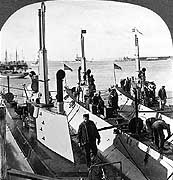|
Photo #: NH 100348 (extended caption) USS K-8 (Submarine # 39), in center With two other submarines, at San Diego, California, circa 1915. Two destroyers and two cruisers are visible in the distance. Photo printed on a stereograph card, published by the Keystone View Company. Donation of Louis Smaus, 1985 U.S. Naval Historical Center Photograph. Online Image: 122KB; 625 x 675 pixels A stereo pair version of this image is available as Photo # NH 100348-A Online Image of stereo pair: 84KB; 675 x 365 pixels Note: See below for the text printed on the reverse of the original stereo card, giving an immediate post-World War I popular evaluation of submarine warfare.. |
 |
Text printed on the reverse of the original stereo card, probably written in about 1919.
|
|
Click on the small photograph to prompt a larger view of the same image.
If you want higher resolution reproductions than this digital image, see: "How to Obtain Photographic Reproductions."
22 November 2004